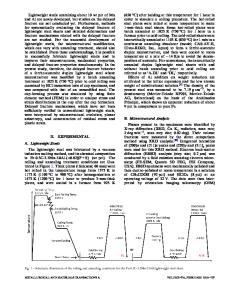Effects of Prior Austenite Grain Size on Hydrogen Delayed Fracture of Hot-Stamped Boron Martensitic Steel
- PDF / 3,622,855 Bytes
- 15 Pages / 593.972 x 792 pts Page_size
- 58 Downloads / 373 Views
.
INTRODUCTION
TO meet the simultaneous demand for a lightweight car body and environmental regulations of the automobile industry, the use of ultra-high-strength sheet steel (UHSS) enables a dramatic mass reduction of the body-in-white and an improvement in the collision characteristics for greater driver safety.[1–3] Martensitic steel, which is a type of UHSS, has been developed with excellent mechanical properties and a significant potential for weight and cost savings.[4] Specifically, hotstamped boron steel and its manufacturing process have recently become a significant area of interest in the current automotive industry.[5] The main method of the hot-stamping process is direct hot stamping, which is a process in which a blank is heated in a furnace, transferred to a press, and subsequently formed and quenched in cooled stamping dies. Full martensitic transformation after hot-stamping manufacturing causes an increase to an extremely high tensile strength.[6,7] However, one issue of concern regarding martensitic steel is its significant vulnerability to hydrogen delayed cracking caused by hydrogen embrittlement. A hydrogen delayed fracture is a phenomenon in which a structural part suddenly fails under a constant stress, which results from hydrogen being introduced into the steel through the product fabrication process or
HYE-JIN KIM is with the Steel Application Engineering Team, Technical Research Center, Hyundai-Steel, 1480 Buckbusaneop-ro, Songak-Eup, Dangjin-Si, Chungnam, 343-823, South Korea. Contact e-mail: [email protected] Manuscript submitted June 22, 2019.
METALLURGICAL AND MATERIALS TRANSACTIONS A
corrosion environment.[8–11] For safe use, it is essential to improve the resistance through microstructural control and suppress the hydrogen inflow from the external surroundings. It was reported that hydrogen flows during the hot-stamping process with respect to different atmospheric sources in an aluminum-coated surface in the furnace. An important aspect of this problem is the continuous evolution of the material during the hot-stamping process. Hydrogen atoms can flow in owing to the influence of the dew point, austenitizing temperature, and holding time of the austenite temperature on the diffusible hydrogen content.[12] It is very important to understand the influence of diffusible hydrogen in the use of hot-stamped martensitic steel in the automotive industry. A hydrogen delayed fracture generally involves a certain interaction among the microstructure, hydrogen absorption, and stress level. The chemical diffusion response of absorbed hydrogen is in homogeneously distributed within the local microstructure of the material owing to the differences in the diffusivity among its complex microstructural characteristics and may have an impact on the unique failure resulting from the initiation of small micro-cracks at a high accumulation of hydrogen content and stress in a localized region, such as inter-granular cracks.[13–15] These localized micro-cracks depend on the inclination of the grain boundarie
Data Loading...











